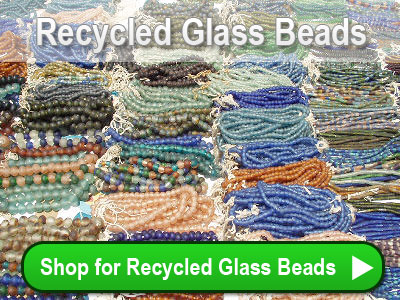Everyone knows there are benefits to recycling. Not only does it reduce the amount of waste going into landfill sites, but creative recycling can also minimize the plethora of noxious gases given off by melting things down industrially. In Ghana, the resourceful Krobo and Asante tribes have long known the benefits of creative upcycling. As early as the 17th Century, they were grinding down old glass beads and bottles for the very purpose of creating beautiful trade bead imitations.
Today, Recycled glass beads are one of the primary exports of the Krobo region, and are distinguishable by their irregular shape and relatively gritty finish. They are similar in aesthetics to Beach Glass Beads, which are created from pieces of eroded glass found along the sea shore. Genuine Beach Glass Beads are a rarity in Africa, and are often quite difficult to drill owing to their already weakened internal structure.
Recycled glass beads are made using an ancient process known as sand-casting. First, a large tray of individual bead molds is fashioned out of mud and clay. Whilst the tray is drying in the sun, Krobo artisans begin grinding down the waste fragments of glass into a fine powder (known as “fritt”). The fritt is then poured into the molds, and the entire tray lowered into a below-ground kiln for firing. Amazingly, the clay absorbs much of the fumes given off during the heating process. When cool, the beads are removed by breaking the clay molds against a stone, then eroded further by ‘washing’ or ‘tumbling’ them in water and sand. This process achieves such a realistic effect, it’s almost impossible to discern the difference between seashore beads and beautiful Krobo replicas!
